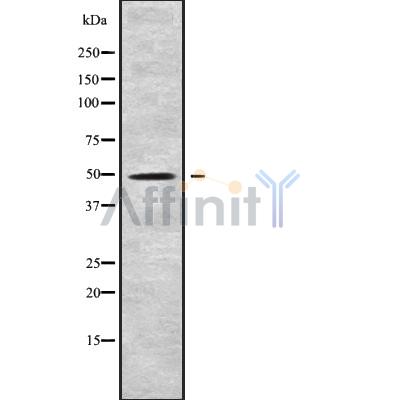KCNJ8 Antibody - #DF9263
| Product: | KCNJ8 Antibody |
| Catalog: | DF9263 |
| Description: | Rabbit polyclonal antibody to KCNJ8 |
| Application: | WB IHC |
| Reactivity: | Human, Mouse, Rat, Rabbit |
| Prediction: | Pig, Zebrafish, Bovine, Horse, Sheep, Dog, Chicken, Xenopus |
| Mol.Wt.: | 48 kDa; 48kD(Calculated). |
| Uniprot: | Q15842 |
| RRID: | AB_2842459 |
Related Downloads
Protocols
Product Info
*The optimal dilutions should be determined by the end user.
*Tips:
WB: For western blot detection of denatured protein samples. IHC: For immunohistochemical detection of paraffin sections (IHC-p) or frozen sections (IHC-f) of tissue samples. IF/ICC: For immunofluorescence detection of cell samples. ELISA(peptide): For ELISA detection of antigenic peptide.
Cite Format: Affinity Biosciences Cat# DF9263, RRID:AB_2842459.
Fold/Unfold
uKATP-1;KCNJ8; Kir6.1;uKATP 1;Potassium channel, inwardly rectifying subfamily J member 8;Inward rectifier K(+) channel Kir6.1;
Immunogens
- Q15842 KCNJ8_HUMAN:
- Protein BLAST With
- NCBI/
- ExPASy/
- Uniprot
MLARKSIIPEEYVLARIAAENLRKPRIRDRLPKARFIAKSGACNLAHKNIREQGRFLQDIFTTLVDLKWRHTLVIFTMSFLCSWLLFAIMWWLVAFAHGDIYAYMEKSGMEKSGLESTVCVTNVRSFTSAFLFSIEVQVTIGFGGRMMTEECPLAITVLILQNIVGLIINAVMLGCIFMKTAQAHRRAETLIFSRHAVIAVRNGKLCFMFRVGDLRKSMIISASVRIQVVKKTTTPEGEVVPIHQLDIPVDNPIESNNIFLVAPLIICHVIDKRSPLYDISATDLANQDLEVIVILEGVVETTGITTQARTSYIAEEIQWGHRFVSIVTEEEGVYSVDYSKFGNTVKVAAPRCSARELDEKPSILIQTLQKSELSHQNSLRKRNSMRRNNSMRRNNSIRRNNSSLMVPKVQFMTPEGNQNTSES
Predictions
Score>80(red) has high confidence and is suggested to be used for WB detection. *The prediction model is mainly based on the alignment of immunogen sequences, the results are for reference only, not as the basis of quality assurance.
High(score>80) Medium(80>score>50) Low(score<50) No confidence
PTMs - Q15842 As Substrate
| Site | PTM Type | Enzyme | Source |
|---|---|---|---|
| S6 | Phosphorylation | Uniprot | |
| T62 | Phosphorylation | Uniprot | |
| S194 | Phosphorylation | Uniprot | |
| K217 | Acetylation | Uniprot | |
| T234 | Phosphorylation | Uniprot | |
| S275 | Phosphorylation | Uniprot | |
| Y278 | Phosphorylation | Uniprot | |
| S281 | Phosphorylation | Uniprot | |
| T283 | Phosphorylation | Uniprot | |
| S385 | Phosphorylation | Uniprot | |
| S397 | Phosphorylation | Uniprot | |
| S403 | Phosphorylation | Uniprot |
Research Backgrounds
This potassium channel is controlled by G proteins. Inward rectifier potassium channels are characterized by a greater tendency to allow potassium to flow into the cell rather than out of it. Their voltage dependence is regulated by the concentration of extracellular potassium; as external potassium is raised, the voltage range of the channel opening shifts to more positive voltages. The inward rectification is mainly due to the blockage of outward current by internal magnesium. Can be blocked by external barium (By similarity).
Membrane>Multi-pass membrane protein.
Predominantly detected in fetal and adult heart.
Belongs to the inward rectifier-type potassium channel (TC 1.A.2.1) family. KCNJ8 subfamily.
Research Fields
· Environmental Information Processing > Signal transduction > cGMP-PKG signaling pathway. (View pathway)
References
Restrictive clause
Affinity Biosciences tests all products strictly. Citations are provided as a resource for additional applications that have not been validated by Affinity Biosciences. Please choose the appropriate format for each application and consult Materials and Methods sections for additional details about the use of any product in these publications.
For Research Use Only.
Not for use in diagnostic or therapeutic procedures. Not for resale. Not for distribution without written consent. Affinity Biosciences will not be held responsible for patent infringement or other violations that may occur with the use of our products. Affinity Biosciences, Affinity Biosciences Logo and all other trademarks are the property of Affinity Biosciences LTD.

